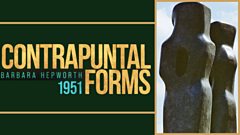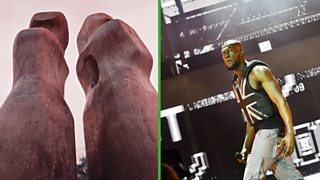Wars and Peace
The world wars force artists to grapple with destruction and savagery, challenging conventions and the old imperial order, while those fleeing war bring new ideas to Britain.
Art goes to war during the first half of the 20th century: war with the old imperial order, war with convention and war with the very idea of what it means to be human. This is a story of artists grappling with the destruction, fighting back and transforming the culture of the Isles.
Actress Michelle Fairley performs WB Yeats’s poem Easter 1916, with its resonant phrase ‘a terrible beauty is born’ marking a turning of the tide against the British Empire. Contemporary war photographer Oliver Chanarin traces the story of William Orpen’s subversive protest image, To the Unknown British Soldier in France, picturing a lone draped coffin amid the magnificence of the Palace of Versailles, where peace delegates met in 1919.
Some artists rejected war with their bohemian lifestyles or their utopian visions of a better future for the people. Artist Lachlan Goudie explores the great interwar shipbuilding project, the Queen Mary ocean liner, with its fusion of Glaswegian engineering and art deco luxury.
As refugees flee Germany in the 1930s ahead of a new war, comedian Eddie Izzard appreciates the radical modernist vision of the De La Warr Pavilion, Bexhill, designed by German and Russian Jewish émigrés, and photographer Hannah Starkey reflects on the outsider’s point of view photographer Bill Brandt brought to his images of 1930s poverty, including the seminal Coal-Searcher Going Home to Jarrow.
With the Second World War bringing new horrors, artists grappled with Nazi atrocities. Film director Andrew MacDonald explores the controversy sparked by The Life and Death of Colonel Blimp, a highly original take on the British war effort written and produced by his grandfather Emeric Pressburger. Artist Ryan Gander examines how sculptor Barbara Hepworth tried to make sense of war by reaching for beauty in abstract human forms, and Denzil Forrester looks ahead to the postcolonial aftermath of war, signalled by Indian artist FN Souza’s suffering black Christ in his 1959 painting Crucifixion.
Last on
More episodes
Previous
Clip
-
![]()
Contrapuntal Forms: Barbara Hepworth at the Festival of Britain
Duration: 01:55
Music Played
-
![]()
Agnes Obel
Fivefold
-
![]()
Giuseppe Verdi
Nabucco: Va Pensiero (Chorus of The Hebrew Slaves)
-
![]()
Sigur Rós
Ba Ba
-
![]()
Air
Astronomic Club
-
![]()
Jon Hopkins
Open Eye Signal
-
![]()
Charles Trenet
Boum
-
![]()
Massive Attack
Future Proof
-
![]()
Nils Frahm
More
-
![]()
Caribou
Bowls
-
![]()
Mogwai
I Know You Are But What Am I?
-
![]()
Lisa Gerrard
Celon
-
![]()
Faithless
Sunday 8pm
-
![]()
David Holmes
The Story Of The Ink
-
![]()
The xx
Chained
-
![]()
Nils Frahm
Kaleidoscope
-
![]()
Seinabo Sey
Pistols At Dawn
-
![]()
Bonobo
���dz��ٳܲ�������
-
![]()
Sandy Nelson
In Beat
-
![]()
György Ligeti
Atmospheres (Excerpt) (2018 Remastered)
-
![]()
Brian Eno
In Dark Trees
-
![]()
The xx
Fantasy
-
![]()
Leftfield
Melt
-
![]()
Ghostpoet
Run Run Run
-
![]()
Aphex Twin
Jynweythek
-
![]()
Pulp
Disco 2000 (7" Mix)
Credits
| Role | Contributor |
|---|---|
| Narrator | David Threlfall |
| Director | Kate Misrahi |
| Producer | Helena Hunt |
| Series Producer | Melanie Fall |
| Executive Producer | Russell Barnes |
| Executive Producer | Denys Blakeway |
| Production Company | ClearStory Ltd |
Broadcasts
- Thu 19 May 2022 21:00
- Tue 31 May 2022 00:45
- Mon 4 Dec 2023 21:00
- Tue 5 Dec 2023 02:45
Saxons to Stormzy: Eight creative moments that defined their era
Be inspired by some of the incredible individuals who disrupted history with their creativity with The Open University
Nine inspiring creative women that history overlooked





